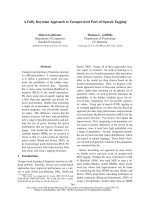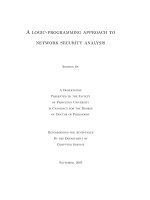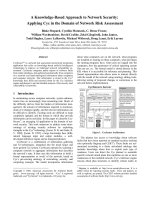A model driven approach to imbalanced data learning
Bạn đang xem bản rút gọn của tài liệu. Xem và tải ngay bản đầy đủ của tài liệu tại đây (1.88 MB, 209 trang )
A MODEL DRIVEN APPROACH TO IMBALANCED
DATA LEARNING
YIN HONGLI
B.Comp. (Hons.), NUS
A THESIS SUBMITTED
FOR THE DEGREE OF DOCTOR OF PHILOSOPHY
DEPARTMENT OF COMPUTER SCIENCE
NATIONAL UNIVERSITY OF SINGAPORE
2011
ACKNOWLEDGMENTS
It has never been a solo effort in completing this thesis. I have received tremendous help
and support from many people during my PhD study. I would like to take this opportunity
to thank the following people who have helped me make this thesis possible, even though
many of the names are not possibly listed below:
Firstly, I would like to thank my supervisor Associate Professor Leong Tze-Yun, from
School of Computing, National University of Singapore, who has been encouraging,
guiding and supporting me all the way from the initial stage to the final stage, and who
has never given up on me; without her, this thesis would not be possible.
Professor Lim Tow Keang, from National University Hospital for providing me the
Asthma data set, and guiding me in the asthma related research.
Dr. Ivan Ng and Dr. Pang Boon Chuan, both from National Neuron Institute for
providing me the mild head injury data set and the severe head injury data set, and whose
collaboration and guidance have helped me a lot in the head injury related research.
Dr. Zhu Ai Ling and Dr. Tomi Silander, both from National University of Singapore, and
Mr Abdul Latif Bin Mohamed Tahiar‟s first daughter Mas, who have spent their valuable
time in proof reading my thesis.
ii
Associate Professor Poh Kim-Leng and his group from Industrial and System
Engineering, National University of Singapore, for their collaboration and guidance in
my idea formulation and daily research.
My previous and current colleagues from Medical Computing Lab, Zhu Ai Ling, Li Guo
Liang, Rohit Joshi, Chen Qiong Yu, Nguyen Dinh Truong Huy and many others, who
have always been helpful in enlightening me and encouraging me during my PhD study.
My special thanks to Zhang Yi who has always encouraged me not to give up, and Zhang
Xiu Rong who has constantly given me a lot of support. My dog Tudou who has always
been there with me especially during my down time.
Last but not least, I would like to thank my parents who have always been supporting me,
especially my father, who has scarified himself for the family and my study, my mother
with schizophrenia, who loves me the most, and my grandpas, who passed away, saving
all their pennies for my study. I owe my family the most!
iii
TABLE OF CONTENTS
Acknowledgments i
Abstract xi
List of Tables xiii
List of Figures xv
Chapter 1: Introduction 1
1. Introduction 1
1.1 Background 1
1.2 Imbalanced Data Learning Problem 3
1.2.1 Imbalanced data definition 3
1.2.2 Types of imbalance 5
1.2.3 The problem of data imbalance 6
1.2.4 Imbalance ratio 7
1.2.5 Existing approaches 7
1.2.6 Limitations of existing work 8
1.3 Motivations and Objectives 9
1.4 Contributions 10
1.5 Overview 11
Chapter 2: Real Life Imbalanced Data Problems 12
2. Real Life Imbalanced Data Problems 12
2.1 Severe Head Injury Problem 12
2.1.1 Introduction 13
2.1.2 Data summary 15
2.1.3 Evaluation measures and data distributions 16
2.1.4 About the traditional learners 17
2.1.4.1 Bayesian Network 17
iv
2.1.4.2 Decision Trees 18
2.1.4.3 Logistic Regression 18
2.1.4.4 Support Vector Machine 19
2.1.4.5 Neural Networks 19
2.1.5 Experiment analysis 20
2.2 Minor Head Injury Problem – A Binary Class Imbalanced Problem 24
2.2.1 Background 24
2.2.2 Data summary 26
2.2.3 Outcome prediction analysis 27
2.2.4 ROC curve analysis 28
2.2.4.1 ROC curve analysis for data with 43 attributes 28
2.2.4.2 ROC curve analysis for data with 38 attributes 30
2.2.4.3 Experiment analysis 32
2.3 Summary 33
Chapter 3: Nature of The Imbalanced Data Problem 34
3. Nature of The Imbalanced Data Problem 34
3.1 Nature of Data Imbalance 35
3.1.1 Absolute rarity 36
3.1.2 Relative rarity 37
3.1.3 Noisy data 38
3.1.4 Data fragmentation 39
3.1.5 Inductive bias 39
3.2 Improper Evaluation Metrics 40
3.3 Imbalance Factors 41
3.3.1 Imbalance level 42
3.3.2 Data complexity 42
3.3.3 Training data size 43
3.4 Simulated Data 43
v
3.5 Results and Analysis 45
3.6 Discussion 46
Chapter 4: Literature Review 50
4. Literature Review 50
4.1 Algorithmic Level Approaches 50
4.1.1 One class learning 50
4.1.2 Cost-sensitive learning 52
4.1.3 Boosting algorithm 53
4.1.4 Two phase rule induction 54
4.1.5 Kernel based methods 55
4.1.6 Active learning 56
4.2 Data Level Approaches 57
4.2.1 Data segmentation 57
4.2.2 Basic data sampling 58
4.2.3 Advanced sampling 59
4.2.3.1 Local sampling 59
4.2.3.1.1 One sided selection 60
4.2.3.1.2 SMOTE sampling 60
4.2.3.1.3 Class distribution based methods 63
4.2.3.1.4 A mixture of experts method 64
4.2.3.1.5 Summary 64
4.2.3.2 Global sampling 65
4.2.3.3 Progressive sampling 65
4.3 Other Approaches 67
4.3.1.1 Place rare cases into separate classes 68
4.3.1.2 Using domain knowledge 68
4.3.1.3 Additional methods 69
4.4 Performance Evaluation Measures 70
vi
4.4.1 Accuracy 71
4.4.2 F-measure 71
4.4.3 G-Mean 72
4.4.4 ROC curves 73
4.5 Discussion and Analysis 74
4.5.1 Mapping of imbalanced problems to solutions 74
4.5.2 Rare cases vs rare classes 76
4.6 Limitations of The Existing Work 77
4.6.1 Sampling and other methods 77
4.6.2 Sampling and class distribution 79
4.7 Summary 79
Chapter 5: A Model Driven Sampling Approach 81
5. A Model Driven Sampling Approach 81
5.1 Motivation 81
5.2 About Bayesian Network 83
5.2.1 Basics about Bayesian network 83
5.2.2 Advantages of Bayesian network 85
5.3 Model Driven Sampling 86
5.3.1 Work flow of model driven sampling 86
5.3.2 Algorithm of model driven sampling 88
5.3.3 Building model 91
5.3.3.1 Building model from domain knowledge 91
5.3.3.2 Building model from data 91
5.3.3.3 Building model from both domain knowledge and data 92
5.3.4 Data sampling 93
5.3.5 Building classifier 94
5.4 Possible extensions 94
5.4.1 Progressive MDS 94
vii
5.4.2 Context sensitive MDS 95
5.5 Summary 95
Chapter 6: Experiment Design and Setup 97
6. Experiment Design and Setup 97
6.1 System Architecture 97
6.2 Data Sets 99
6.2.1 Simulated data sets 99
6.2.1.1 Two dimensional data 99
6.2.1.2 Three dimensional data 100
6.2.1.3 Multi – dimensional data 101
6.2.2 Real life data sets 103
6.3 Experimental Results 105
6.3.1 Running results on simulated data 105
6.3.1.1 Circle data 105
6.3.1.2 Half-Sphere data 106
6.3.1.3 ALARM data 106
6.3.2 Running results on real life data sets 107
6.3.2.1 Asia data 107
6.3.2.2 Indian Diabetes data 108
6.3.2.3 Mammography data 108
6.3.2.4 Head Injury data 109
6.3.2.5 Mild Head Injury data 109
6.4 Summary 110
Chapter 7: MDS in Asthma Control 113
7. MDS in Asthma Control 113
7.1 Background 113
7.2 Data Sets 114
7.2.1 Data description 114
viii
7.2.2 Data preprocessing 116
7.2.2.1 Feature selection 116
7.2.2.2 Discretization 117
7.3 Running Results 117
7.3.1 Asthma first visit data 118
7.3.2 Asthma subsequent visit data 119
7.4 Summary 121
Chapter 8: Progressive Model Driven Sampling 122
8. Progressive Model Driven Sampling 122
8.1 Class Distribution Matter 122
8.2 Data Sets and Class Distributions 124
8.2.1 Data sets 124
8.2.2 Data distributions 124
8.3 Experiment Design in Progressive Sampling 127
8.4 Experimental Results 128
8.4.1 Experimental results for circle data 129
8.4.2 Experimental results for sphere data 129
8.4.3 Experimental results for asthma first visit data 131
8.4.4 Experimental results for asthma sub visit data 132
8.5 Summary 134
Chapter 9: Context Senstive Model Driven Sampling 135
9. Context Sensitive Model Driven Sampling 135
9.1 Context Sensitive Model 135
9.2 Context in Imbalanced data 136
9.3 Data Sets 137
9.3.1 Simulated Data 138
9.3.2 Asthma first visit data 139
9.3.3 Asthma sub visit data 140
ix
9.4 Experiment Design 141
9.5 Experimental Results 143
9.5.1 Sphere data 143
9.5.2 Asthma first visit data results 145
9.5.3 Asthma sub visit data results 145
9.6 Discussions 146
Chapter 10: Conclusions 148
10. Conclusions 148
10.1 Review of Existing Work 148
10.2 Countributions 149
10.2.1 The global sampling method 149
10.2.2 MDS with domain knowledge 149
10.2.3 MDS combined with progressive sampling 151
10.2.4 Context sensitive MDS 151
10.3 Limitations 152
10.4 Future work 152
10.4.1 Future work in asthma project 152
10.4.2 Future work in MDS 153
APPENDIX A: Asthma First Visit Attribtues 155
APPENDIX B: Asthma Subsequent Visit Attributes 159
APPENDIX C: Related Work - Bayesian Network 163
C.1. Structure Learning 163
C.2. Parameter Learning 164
C.3. Constructing From Domain Knowledge 165
C.4. Context sensitive Bayesian network 166
C.4.1. Context Definition in Bayesian Network 166
C.4.2. Bayesian Multinet 168
C.4.3. Similarity Networks 169
x
C.4.4. Tree Structure Representation 172
C.4.5. Natural Language Representation 173
C.5. Inferencing 174
C.6. Data Sampling Methods 175
C.6.1. Importance Sampling 176
C.6.2. Rejection Sampling 177
C.6.3. The Metropolis Method 178
C.6.4. Gibbs Sampling 180
Bibliography 181
xi
ABSTRACT
Many real life problems, especially in health care and biomedicine, are characterized by
imbalanced data. In general, people tend to be more interested in rare events or
phenomena. For example, in prognostic predictions, the physicians can take necessary
precautions to reduce the risks of the small group of patients who cannot recover in time.
Traditional machine learning algorithms often fail to predict the minorities that are of
interest. The objective of imbalanced data learning is to correctly identify the rarities
without sacrificing prediction of the majorities.
In this thesis, we review the existing approaches to deal with the imbalanced data
problem, including data level approaches and algorithm level approaches. Most data
sampling approaches are ad-hoc and the exact mechanisms of how they improve
prediction performance are not clear. For example, random sampling generates duplicate
samples to “fool” the classifier to bias its decision in favor of minorities. Oversampling
often leads to data overfitting, and under sampling tends to remove useful information
from the original data set. The Synthetic Minority over-Sampling Technique creates
synthetic data from the nearest neighbor, but it only makes use of local information and
often leads to data over-generalization. On the other hand, most of the algorithmic level
approaches have been shown to be equivalent to data sampling approaches. Some other
approaches make additional assumptions. For example, a popular approach is cost
xii
sensitive learning which assigns different cost values to different types of
misclassifications; but the cost values are usually unknown, and it is hard to discover the
right cost value.
We propose a model driven sampling (MDS) approach that can generate new
samples based on the global understanding of the entire data set and domain experts‟
knowledge. This is a first attempt to make use of probabilistic graphical methods to
represent the training space and generate synthetic data. Our empirical studies show that
in a large class of problems, MDS generally outperforms previous approaches or
performs comparably to the best previous approach in the worst case scenario. It
performs especially well for extremely imbalanced data without complex connected
structures. MDS also works well when domain knowledge is available, as the model
created with domain knowledge is better “educated” than that constructed purely from
training data and thus, the synthetic data generated are more meaningful. We have also
extended MDS to context sensitive MDS and progressive MDS. Context sensitive MDS
reduces the problem size by creating more accurate sub models for each individual
context. Therefore, the data sampled from context sensitive MDS are more relevant to
each context. Instead of assuming the optimal distribution is balanced, progressive MDS
iterates over all possible data distributions and selects the best performing data
distribution as the optimal distribution. Therefore, progressive MDS improves over MDS
by always obtaining the optimal data distribution, as shown by our empirical studies.
xiii
LIST OF TABLES
Number Page
Table 2-1 Description of head injury dataset with list of prognostic factors 14
Table 2-2 Results for 5 class labels 21
Table 2-3 Results for 2 class labels (death vs all others) 22
Table 2-4 Results for 2 class labels (death-vegetative vs others) 22
Table 2-5 Results for 2 class labels (good recovery & mild-disable vs others) 22
Table 2-6 Results for 2 class labels (good recovery vs others) 23
Table 2-7 Outcome prediction results comparison for mild head injury 28
Table 2-8 Sensitivity and specificity analysis for 43 attributes 29
Table 2-9 Area Under the Curve for 43 attributes 30
Table 2-10 Sensitivity and specificity analysis for 38 attributes data 31
Table 2-11 Area Under the Curve for 38 attributes 32
Table 4-1 Performance Evaluation Metrics 71
Table 4-2 Mapping of imbalanced problems to solutions 75
Table 6-1 - Class distributions (in numbers) 103
Table 6-2 Running Results on Circle Data (P-value < 0.01) 106
Table 6-3 Running Results on Half-Sphere Data (P-value <0.05) 106
Table 6-4 Running Results on ALARM Data (P-value < 0.05) 107
Table 6-5 - Asia data running results 108
Table 6-6 - Indian Diabetes data running results 108
Table 6-7 - Mammography data running results 109
Table 6-8 Running results for Head Injury data 109
Table 6-9 Running results for Mild Head Injury data 110
Table 7-1 Data sets collected from our asthma program 115
xiv
Table 7-2 Asthma first visit running results- 40 features out of 138 116
Table 7-3 Asthma first visit running results - 20 features out of 138 117
Table 7-4 Asthma first visit data running results with 7 features 119
Table 7-5 Asthma Sub Visit Results (40-feature set) 120
Table 7-6 Asthma Sub Visit Results (21-feature set) 120
Table 7-7 Asthma Sub Visit Results (6-feature set) 120
Table 8-1 Data summaries for progressive sampling 124
Table 8-2 Progressive sampling distributions for Circle data 125
Table 8-3 Progressive data distributions for Sphere 125
Table 8-4 Progressive data distributions for asthma first visit 126
Table 8-5 Progressive data distributions for asthma sub visit 126
Table 8-6 g-Mean value for progressive sampling running results in Circle 20 data 129
Table 8-7 g-Mean value for progressive sampling in Sphere data 130
Table 8-8 g-Mean value for progressive sampling in asthma first visit data 131
Table 8-9 g-Mean value on progressive data sampling in asthma sub visit data 132
Table 8-10 Optimal data distributions for various approaches 133
Table 9-1 Data samples of the sphere 138
Table 9-2 Asthma first visit data distribution w/o context 139
Table 9-3 Asthma sub visit data distribution w/o context 140
Table 9-4 Results without context 143
Table 9-5 Running results for upper sphere 144
Table 9-6 Running results for under sphere 144
Table 9-7 Running Results for total sphere with context 144
Table 9-8 Confusion matrix for context sensitive MDS in asthma first visit data 145
Table 9-9 Asthma subsequent visit data‟s performance with context 146
xv
LIST OF FIGURES
Number Page
Figure 1-1 a balanced dataset example 4
Figure 1-2 an imbalanced dataset example 4
Figure 1-3 an example of within class imbalance 6
Figure 2-1 Data distribution with GOS score 16
Figure 2-2 Data distribution with different class labels 21
Figure 2-3 Minor head injury outcome distribution 27
Figure 2-4 ROC curve analysis for mild head injury dataset with 43 attributes 29
Figure 2-5 ROC curve analysis for mild head injury dataset with 38 attributes 31
Figure 3-1 the impact of absolute rarity 36
Figure 3-2 the effect of noisy data on rare cases 39
Figure 3-3 A Backbone Model of Complexity 2 44
Figure 3-4 Performance of simulated data with complexity level c = 1 47
Figure 3-5 Performance of simulated data with complexity level c = 2 47
Figure 3-6 Performance of simulated data with complexity level c = 3 48
Figure 3-7 Performance of simulated data with complexity level c = 4 48
Figure 3-8 Performance of simulated data with complexity level c = 5 49
Figure 4-1 Local sampling with instance A 60
Figure 4-2 Synthetic samples generated by SMOTE 62
Figure 4-3 Over generalization caused by SMOTE 62
Figure 4-4 Data over-generalization caused by SMOTE 63
Figure 4-5 Global sampling with all data samples 66
Figure 4-6 an example of ROC curves 74
Figure 5-1 Domain knowledge in building a model 82
xvi
Figure 5-2 The visit-to-Asia Bayesian Network 84
Figure 5-3 Work flow in model driven sampling classification 87
Figure 6-1 Experiment design for comparing different approaches 98
Figure 6-2 Two dimensional data set 99
Figure 6-3 Three dimensional data - half sphere 101
Figure 6-4 Multi dimensional data set 102
Figure 6-5 A Logical Alarm Reduction Mechanism [ALARM] 102
Figure 6-6 - Data class distributions (in relative ratios) 104
Figure 6-7 Learning scopes for 3 sampling approaches 112
Figure 6-8 Overall comparisons among simulated data 112
Figure 6-9 Overall performance (G-Mean) comparison 112
Figure 8-1 System accuracy versa the number of generated samples 123
Figure 8-2 System flow for progress sampling 127
Figure 8-3 Progressive sampling results for various approaches in Circle data 130
Figure 8-4 Experimental results for progressive sampling in sphere 131
Figure 8-5 Experimental results in progressive sampling for asthma first visit data 133
Figure 8-6 Experimental results for progressive sampling in asthma sub visit 134
Figure 9-1 Simulated Context Specific Data 138
Figure 9-2 Asthma first visit data distribution with context 140
Figure 9-3 Asthma subsequent visit data distribution with context 141
Figure 9-4 Work flow for context sensitive sampling 141
Figure C-1 Context Specificity in Bayesian Network 168
Figure C-2 A Bayesian multinet representation for leucocythemia example 168
Figure C-3 A similarity network representation 170
Figure C-4 Similarity Network Representation of leucocythemia 171
Figure C-5 Tree structure representation 172
Figure C-6 Importance Sampling 177
Figure C-7 Rejection Sampling 178
xvii
Figure C-8 Metropolis method, Q(x'; x) is here shown as a shape that changes with x 179
1
CHAPTER 1: INTRODUCTION
1. INTRODUCTION
1.1 BACKGROUND
In healthcare, a lot of data have been collected by various institutions and hospitals.
These data are valuable resources for outcomes analysis to help doctors to make
decisions on disease diagnosis, resource planning, and risk analysis. The definition of
outcomes here includes functional outcomes, return to work, quality of life, patient
satisfaction, and cost effectiveness. Successful outcomes analysis can help physicians
make better decisions about patients‟ treatments, help in their recovery and cut treatment
cost [10, 124].
In health care outcomes analysis, the critical patients normally constitute a very
small portion of the whole patient population [137], which leads to the class imbalance
problem. For example, this problem was reported in the diagnoses of rare medical
conditions such as thyroid diseases [101], asthma control [159], outcomes analysis for
severe head injury and mild head injury [158], etc. Besides health care, the class
imbalance problem is also widely reported in a lot of other areas with significant
environmental, vital or commercial importance [69]. For example, the problem was
reported in the detection of oil spills in satellite radar images [83], the detection of
2
fraudulent telephone calls [46], in-flight helicopter gearbox fault monitoring [67],
software defect prediction [162], information retrieval and filtering [86], etc.
Empirical experience shows that traditional data mining algorithms fail to
recognize critical patients who are normally the minorities, even though they may have
very good prediction accuracy for the majority class. Thus imbalanced data learning – to
build a model from the imbalanced data and correctly recognize both majority and
minority examples is a very crucial task [87, 159]. Existing approaches mainly include
data level approaches [22, 23, 35, 81] and algorithmic level approaches [27, 42, 67, 74,
76, 82, 127]. In this thesis, we mainly focus on data sampling approaches, because
empirical studies show that data sampling is more efficient and effective than algorithmic
approaches [44, 149]. We have studied the state of the art data sampling approaches –
random sampling approach, Synthetic Minority over-Sampling Technique (SMOTE)
[23], and progressive sampling [50, 104]. These approaches mainly either duplicate the
existing data samples, or create synthetic samples with the nearest neighboring sample. In
contrast to the existing approaches, we propose a Model Driven Sampling (MDS)
approach to make use of the whole training space and domain knowledge to create
synthetic data. To our best knowledge, MDS is the first approach using probabilistic
graphical models to model the training space and domain knowledge to generate
synthetic data samples.
In this thesis, we compare MDS with existing data sampling approaches on
various training data, using different machine learning techniques and evaluation
3
measures. In particular, Bayesian networks are used to create models in MDS and also
used as the data classifier for the evaluation; g-Mean [81] is used as the evaluation
metric. MDS is empirically shown to outperform other data sampling approaches in
general. It is particularly useful for highly skewed data, and sparse data with domain
knowledge. Context sensitive MDS can usually reduce the problem size, and generate
more accurate data adapted to each context. Progressive sampling can be combined with
MDS to determine the optimal data distribution, instead of using the balanced data
distribution that may not be optimal.
1.2 IMBALANCED DATA LEARNING PROBLEM
1.2.1 IMBALANCED DATA DEFINITION
The word “imbalanced” is an antonym for the word “balanced”; Imbalanced dataset
refers to the dataset with unbalanced class distribution. Figure 1-1 shows a balanced data
distribution – the Singapore population sex distribution with sex as of July 2006 [4]. The
number of males and the number of females are roughly equal for each age group. Figure
1-2 illustrates an example of an unbalanced dataset where mild head injury patients
greatly outnumber severe head injury patients in a head injury dataset [111].
4
Figure 1-1 a balanced dataset example
Figure 1-2 an imbalanced dataset example
Class distribution plays an important role in learning. In real life datasets,
particularly in medical datasets, class distribution is often uneven, or even highly skewed.
For example, in the dataset shown in Figure 1-2, there are only 30 positive (severe) cases
Singapore Population as July 2006
0
500,000
1,000,000
1,500,000
2,000,000
0-14 15-64 65 -
Age group
Population size
Male
Female
Head Injury Data - an Imbalanced Dataset
0
500
1000
1500
2000
1
Head Injury Severity
Number of Patients
Severe
Mild
5
among a total of 1806 head injury patients. There are many more negative examples than
positive examples in this dataset, which is therefore imbalanced.
In this work, we focus on imbalanced data learning in the context of biomedical
or healthcare outcomes analysis. It is defined as learning from an imbalanced dataset and
building a decision model which can correctly recognize the outcomes especially for the
minority classes. We assume that the training data are limited, and rare cases and rare
classes (discussed in session 4.5.2) exist in the data space.
1.2.2 TYPES OF IMBALANCE
Most of the research on rarity relates to rare classes or more generally, class imbalance.
This type of rarity is mainly associated with classification problems. The head injury data
set in Figure 1-2 is an example of class imbalance. This type of imbalance is also referred
to as “between class” imbalance.
Another type of rarity concerns rare cases. A rare case is normally a sub concept
defined within a class that occurs infrequently. For example, in Figure 1-3, the population
is a balanced dataset with two classes male and female. However, within each class, age
group “0-14” and age group “65-” are rare cases. Unfortunately, it is very hard to detect
rare cases in real life, though clustering method may help to identify them. Rare cases,
like rare classes, can be considered as a form of data imbalance and it is normally
referred to as “within class” imbalance [72].
6
Figure 1-3 an example of within class imbalance
1.2.3 THE PROBLEM OF DATA IMBALANCE
The traditional machine learners assume that the class distribution for the testing data is
the same as the training data, and they aim to maximize the overall prediction accuracy
on the testing data. These learners usually work well on the balanced data, but often
perform poorly on the imbalanced data, misclassifying the minority class, which is
normally unacceptable in reality. For example, as shown in the head injury data in Figure
1-2, a trivial classifier can easily achieve 99% accuracy, but it misses all the severe head
injury cases. The consequence is very costly – clinicians would miss the best chance to
treat those patients who will turn out to be severe.
In order to properly address the imbalanced data problem, the following issues
must be considered: a better evaluation metric which is not sensitive to data distribution
Singapore Population
0
500,000
1,000,000
1,500,000
2,000,000
Male Female
Sex
Population
0-14
15-64
65 -
7
should be used; traditional learners should be modified to reduce the bias on minority
predictions; or the training space can be re-sampled to form a proper balanced data set, so
that existing learners can be applied. We will review all these methods in detail in
Chapter 4.
1.2.4 IMBALANCE RATIO
A central concept in imbalanced data learning is the imbalance ratio. We define
imbalance ratio as the percentage of minority samples among the total sample space. For
example in a sample space of 100 examples where 30 are minorities, the imbalance ratio
will be 30/100=30% or 0.3.
1.2.5 EXISTING APPROACHES
Existing imbalanced data learning techniques can be generally categorized into two types
– algorithm level approaches and data level approaches. Algorithm level approaches
either alter the existing machine learning approaches or create new algorithms for
addressing the imbalanced data problems. Data level approaches alter the training data
distributions by various data sampling techniques. Algorithm level approaches include
learning rare class only [67, 82, 100, 127], cost sensitive learning [28, 33, 37, 84, 97, 107,
133, 149], boosting algorithm [27, 45, 76] [75], two phase rule induction [74], kernel
modification methods [54, 65, 154, 155], etc. Data level approaches include random
oversampling and under-sampling [24, 35, 44, 117], informed under-sampling [93],
synthetic sampling with data generation [23], adaptive synthetic sampling [58, 61],
sampling with data cleaning techniques [12], cluster based sampling method [73],









